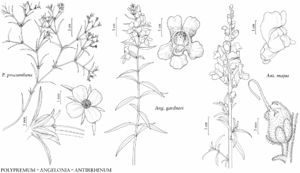Antirrhinum majus
Sp. Pl. 2: 617. 1753.
Stems terete, 3–8 (–15) dm, glabrous or sparsely stipitate-glandular proximally, stipitate-glandular distally. Leaves: blade narrowly elliptic to lanceolate, 50–70 × 5–20 mm, glabrous or sparsely stipitate-glandular proximally. Inflorescences stipitate-glandular, sometimes glabrous; bracts similar to distal leaves. Pedicels 1–7 mm, stipitate-glandular. Flowers: sepals 5–10 mm, stipitate-glandular; corolla palate yellow; filaments 20–40 mm. Capsules 7–10 mm wide. 2n = 16 (Europe).
Phenology: Flowering May–Oct.
Habitat: Disturbed ground.
Elevation: 0–2000 m.
Distribution
Introduced; B.C., Ont., Que., Calif., Conn., D.C., Ill., Iowa, La., Mass., Mich., Mo., N.Y., Ohio, Oreg., Pa., Utah, Vt., Va., Wash., Wis., sw Europe, also in Mexico, West Indies, Central America, South America, Asia, Africa, Australia
Discussion
Antirrhinum majus is a popular garden plant grown as an annual; it occasionally escapes but is short-lived. Some cultivars have been developed with different growth forms, corolla colors, or open-throated flowers.
Selected References
None.
Lower Taxa
"dm" is not declared as a valid unit of measurement for this property."dm" is not declared as a valid unit of measurement for this property.
